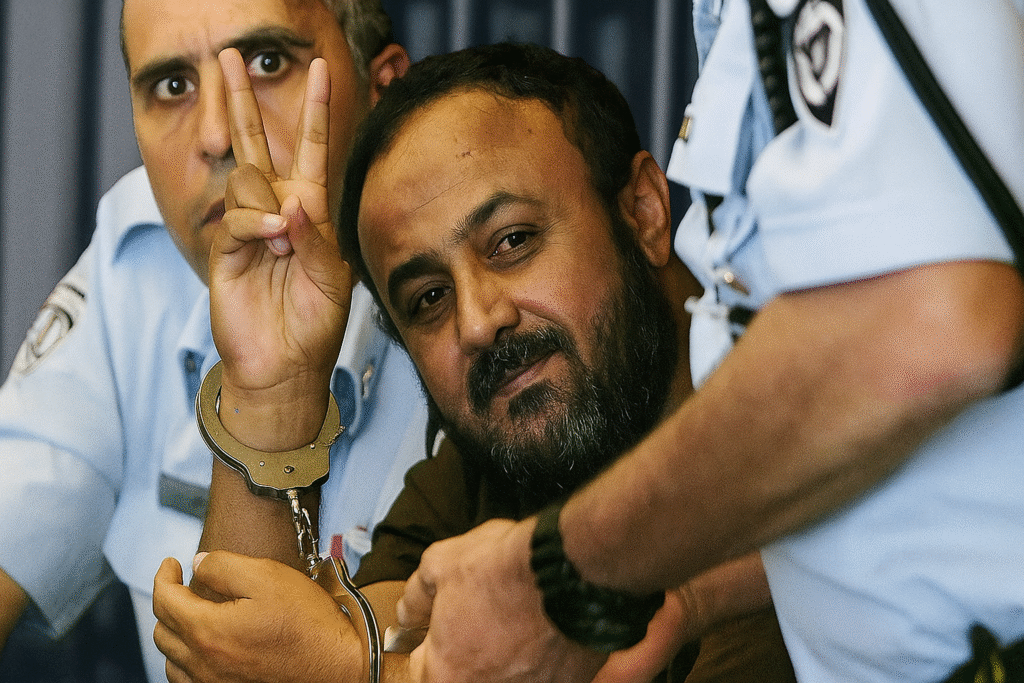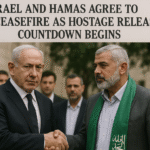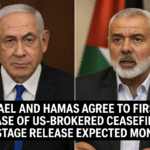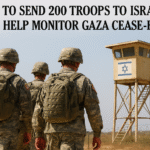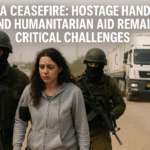By Harshit | October 12, 2025 | Gaza/Israel
Hamas Demands Release of Prominent Palestinian Prisoners
Hamas continues to push Israel for the release of seven high-profile Palestinian prisoners, including Marwan Barghouti and Ahmad Saadat, as part of ongoing ceasefire and hostage negotiations. The group has emphasized that these prisoners, who carry the highest sentences among Palestinians held in Israel, are central to any potential deal and that their release could accelerate the handover of Israeli hostages.
A Palestinian official familiar with the talks told the BBC that the negotiations began Friday morning, aiming to resolve outstanding issues surrounding the prisoner list. Hamas reportedly indicated to mediators that even the release of just two high-profile prisoners could prompt an earlier transfer of hostages than currently scheduled for Monday. Israel, however, has consistently refused to release the seven prisoners so far, complicating the delicate negotiations.
Who Are Marwan Barghouti and Ahmad Saadat?
Marwan Barghouti, a senior leader of the Fatah faction that dominates the Palestinian Authority (PA), is serving five life sentences plus 40 years for orchestrating attacks that killed four Israelis and a Greek monk in 2004. Despite his imprisonment, Barghouti remains a highly influential and popular figure among Palestinians. Polls consistently indicate that he would receive more votes than PA President Mahmoud Abbas or leading Hamas officials in a hypothetical presidential election. His enduring popularity makes him a key figure in the ongoing political landscape of the West Bank, which remains under partial PA governance.
Ahmad Saadat is the leader of the Popular Front for the Liberation of Palestine (PFLP), a faction that also maintains influence in the PA. Saadat was convicted in 2008 of heading an “illegal terrorist organization” and involvement in attacks, including the assassination of an Israeli minister in 2001. He was sentenced to 30 years in prison. Both Saadat and Barghouti are seen as symbolic leaders by Palestinians and their potential release is considered pivotal by Hamas in the context of broader political and hostage negotiations.
Gaza in the Aftermath of Conflict
While negotiations over prisoners continue, Palestinians are returning to northern Gaza, including Gaza City, after being displaced during Israel’s military offensive. Thousands have traveled up Gaza’s coastal highway to reach their homes, only to find widespread destruction. Reports indicate that as many as three-quarters of buildings in Gaza City have been damaged. Residents are surveying rubble and attempting to rebuild amid limited resources.
Humanitarian aid remains a critical concern. While aid trucks have entered Gaza, UN agencies like UNICEF have emphasized that current access falls short of the urgent needs. Aid distribution is being limited by the availability of crossing points, with experts recommending multiple entry routes to improve the flow of food, medical supplies, and essential goods. Israeli officials, however, claim aid has been flowing since before the ceasefire and have accused some organizations of being used as political tools by Hamas.
Key Developments Expected in the Next 24 Hours
The next 24 hours are critical in implementing the ceasefire between Israel and Hamas. The following developments are expected:
- Hamas is anticipated to release all living Israeli hostages by Monday noon local time (10:00 BST) in a private transfer. The hostages will be taken to Israel for medical attention.
- Israel will release hundreds of Palestinian prisoners and approximately 1,700 detainees in Gaza, following preparation for their release.
- International attention will focus on US President Donald Trump’s visit to Israel and Egypt, where he plans to formalize the ceasefire deal alongside other world leaders, including Emmanuel Macron of France and Keir Starmer of the UK.
Security Concerns and Post-War Stability
Security in Gaza remains a major concern following the ceasefire. Hamas has reportedly mobilized thousands of fighters to prevent rival clans from seizing territory and to maintain law and order. Experts warn of the risk of civil conflict, highlighting the challenges of post-war governance in a shattered territory.
A civil-military coordination center is planned in Israel, likely in Ashdod, with US troops assisting in logistics. An international monitoring force, potentially comprising Qatari, Egyptian, Turkish, and UAE personnel, will oversee the ceasefire but will not engage in combat. Their role is primarily to monitor compliance, ensure a stable handover of hostages, and maintain ceasefire terms while preventing renewed hostilities.
Conclusion
The release of Marwan Barghouti, Ahmad Saadat, and other high-profile prisoners remains a central point of tension in ongoing Israel-Hamas negotiations. While progress has been made in the broader ceasefire and humanitarian access, the political and security complexities surrounding prisoner releases highlight the fragility of peace efforts. The next 24–48 hours will be pivotal in determining the immediate future of Gaza, the hostages, and broader regional stability.

